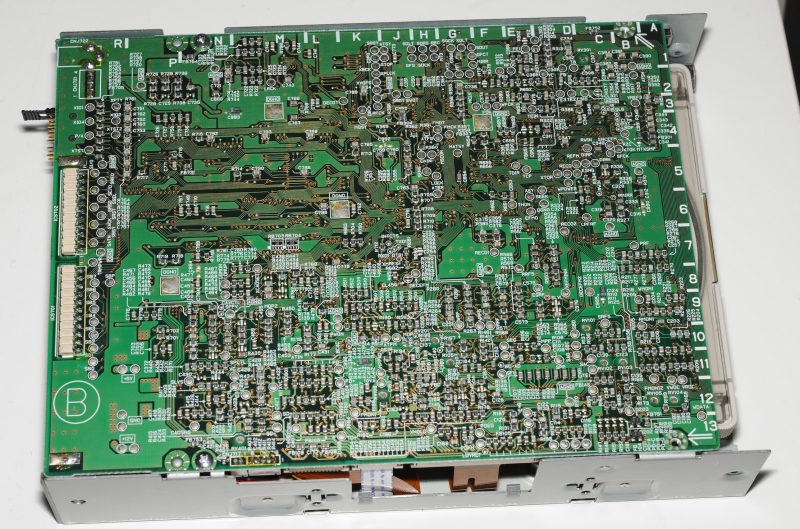Recently I was looking around on eBay for an Adaptec SlimSCSI PCMCIA card – for an escapade unrelated to this post, there was of course one there for sale, for a reasonable price, but it included this lump of a CD Burner which I really didn’t want.
I was tempted to just throw it straight in the trash… but…
This happens to be one of the very earliest commercially available 2x (two-spin) units, which likely had a list price of thousands of dollars. I remember hearing about these things in the early to mid 1990s but I never actually saw one with my own eyes.
I knew someone who worked for a company who owned one – he would sneak into the room it lived in after hours to create his own music CDs. He was eventually caught, and sacked. Unfortunately his severance didn’t include the CD Burner.
I didn’t get access to anything like this until around 1999, and that would have been a much more modern 8x4x24 IDE unit which sold at a price affordable to the average person.
Anyway… let’s take a look at this beast.
The first noticeable feature is that it is a “Caddy” drive. These were common during the very early days of CD-ROMs because software CDs in particular cost a lot of money, and most people didn’t have a way to copy them, so paying extra for a caddy was worthwhile to protect the investment. Such CD-ROMs were loaded into a caddy, and left there, reducing the chances of damage to practically zero.
It was common for cheaper CDs to be swapped between caddies as the caddies themselves weren’t especially cheap either. In the end CD-ROMs got cheaper and all the caddy swapping just irritated people. Having a CD Burner eliminated the problem caddies were designed to solve entirely, making it a rather interesting feature for this unit.
Another interesting feature is the SCSI interface. This is because it is an external unit – early CD burners like this were typically standalone because they were insanely expensive, and moved from computer to computer as required. A PCMCIA type attachment as I have shown would have been a popular choice as the unit could be connected to any desired laptop without having to purchase and fit a SCSI adapter to each.
The reason for the choice of SCSI over the more common IDE interface, is that IDE never had a standardised external connection mechanism (although it was possible at a pinch). There was no point in defining one because it was not hot-pluggable, and indeed the consequences of disconnecting drives during operation were generally dire. It was also an un-terminated bus, meaning it would be clobbered by signal reflections if cables were over 30CM or so. Adding additional connectors required for an external interface would have exacerbated the problem significantly.
SCSI on the other hand with hot-swapping built in from the get-go, and with its integral termination mechanism was ideal for this kind of application.
Time to take it apart…
As can be seen from the outside, this is a big unit. We can see it has its own built-in switching power supply down the right hand side. Also as expected a standard form factor 5 1/4″ drive with an interesting bespoke mounting solution. Sony likely also sold this as an internal drive (CDU920S).
Next step is to pull the drive out, and open its top cover.
We are immediately presented with the main PCB, which has a lot of components on it.
And – yup – on the other side as we would expect there is a ridiculous number of chips on it. A modern CD/DVD burner only has two or three chips at most.
Lastly the caddy and optical mechanism. Quite a bit of extra stuff there to deal with that caddy!
Burning a CD with it
I went to the trouble of installing Adaptec Easy CD Creator 4 on an old PC to see if I could make it work. After hours of frustration I gave up. I think it has some hardware issues – as when a disc is inserted it just makes a lot of spinning up / spinning down / clunking noises, doing very little else.
Posted in Vintage PC







You might try to figure out if it’s the CD-R that’s the real problem. IIRC there was a few different formats floating around at the time for writable CDs, and regular commercially pressed CDs were only ~650 MB. Optical drives were notoriously quirky about media quality, format, and other “magical” things the average consumer didn’t think about and most modern drives have internal firmware adjustments for those quirks that may not have been the case in the early to mid 90s.
That said, my experience with CD burners from around 96/97 was abysmal. Half the burns would be useless even on high quality systems because many computer systems just couldn’t feed the write stream reliably for the amount of time it took to write a CD. You ended up with the dreaded “underwrite” condition which drives and software eventually solved a few generations later.
I think you are probably right to an extent. I can’t imagine what kind of media people would have been using on these in 1993! Probably something sold by Sony for a hefty price tag.
It does also struggle to read pristine pressed CDs so I believe it does have issues. Likely all it needs is to have its factory calibration re-run. Eh. Not really interesting enough to me to spend any more time on.
I had one of these and tried it on an Adaptec scsi controller. The controller was max transfer of 10mb and I had to reduce the transfer speed to 5mb because of underrun messages.
I still have though unused the last generation.
mVh
Jannik